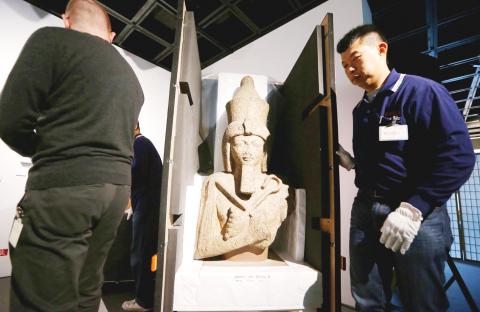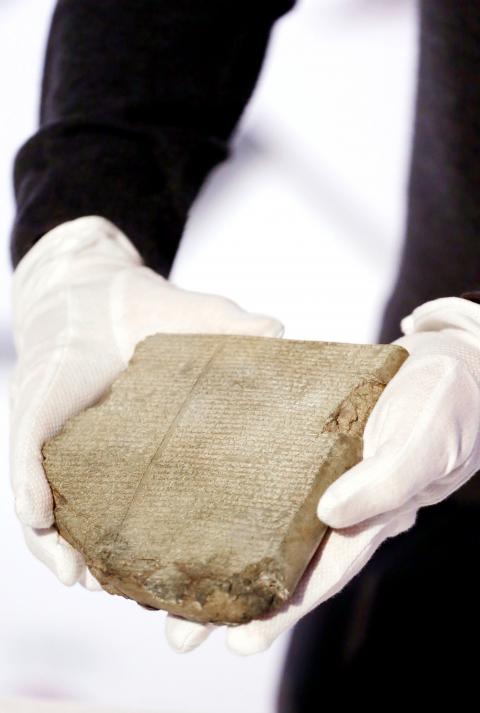An exhibition that tells the history of the world through 100 items is to open at the National Palace Museum in Taipei on Saturday to celebrate the 90th anniversary of the museum next year.
“A History of the World in 100 Objects” uses artifacts that date from 2 million years ago to the present to illuminate how humans have shaped the world and been shaped by it, said Daniel Sung (宋兆霖), lead curator of the museum’s rare books and historical documents division.
The exhibition, organized by the museum and the British Museum, is part of a world tour of the latter’s “A History of the World in 100 Objects” exhibition. Taipei is the first leg of the tour in Asia.

Photo: CNA
Four of the precious objects set to be displayed were revealed at a press conference on Monday.
One is an old stone chopping tool dated to between 1.8 million and 2 million years ago. It is the oldest human-made object in the British Museum and one of the oldest known objects made by humans.
Discovered in Tanzania, the chopping tool was used by ancient humans to chop plants and wood, and break open animal bones to obtain the marrow inside.

Photo: CNA
“Human beings used these kinds of chopping tools to obtain high-calorie food, which fed the development of a larger and more complex brain that was capable of developing new strategies for survival,” Sung said.
Another object is a clay tablet with cuneiform script written on it dated to between 700 BC and 600 BC. The tablet contains a chapter from the Epic of Gilgamesh, which is considered the world’s first great work of literature.
The two other objects are a 1280 BC granite statue of Ramses II, a celebrated Egyptian pharaoh, and a 1515 woodcut print of a rhinoceros by Albrecht Durer.
An Indian sultan gave the rhinoceros print to the king of Portugal in 1515 when Portugal was aiming to set up its first permanent base in India, the National Palace Museum said.
Visitors can visit the exhibition for art education purposes or if they just want to learn more about world history, Sung said.
“A History of the World in 100 Objects” began as a radio series that was jointly produced by BBC Radio 4 and the British Museum in 2010. The radio series drew millions of listeners and the success led to a book being published later that year.
About half of the items on display in Taipei will be from the original series, with the rest from other collections at the British Museum.
The exhibition runs until March 15 next year.

SHIPS, TRAINS AND AUTOMOBILES: The ministry has announced changes to varied transportation industries taking effect soon, with a number of effects for passengers Beginning next month, the post office is canceling signature upon delivery and written inquiry services for international registered small packets in accordance with the new policy of the Universal Postal Union, the Ministry of Transportation and Communications said yesterday. The new policy does not apply to packets that are to be delivered to China, the ministry said. Senders of international registered small packets would receive a NT$10 rebate on postage if the packets are sent from Jan. 1 to March 31, it added. The ministry said that three other policies are also scheduled to take effect next month. International cruise ship operators

NUMBERS IMBALANCE: More than 4 million Taiwanese have visited China this year, while only about half a million Chinese have visited here Beijing has yet to respond to Taiwan’s requests for negotiation over matters related to the recovery of cross-strait tourism, the Tourism Administration said yesterday. Taiwan’s tourism authority issued the statement after Chinese-language daily the China Times reported yesterday that the government’s policy of banning group tours to China does not stop Taiwanese from visiting the country. As of October, more than 4.2 million had traveled to China this year, exceeding last year. Beijing estimated the number of Taiwanese tourists in China could reach 4.5 million this year. By contrast, only 500,000 Chinese tourists are expected in Taiwan, the report said. The report

HORROR STORIES: One victim recounted not realizing they had been stabbed and seeing people bleeding, while another recalled breaking down in tears after fleeing A man on Friday died after he tried to fight the knife-wielding suspect who went on a stabbing spree near two of Taipei’s busiest metro stations, Taipei Mayor Chiang Wan-an (蔣萬安) said. The 57-year-old man, identified by his family name, Yu (余), encountered the suspect at Exit M7 of Taipei Main Station and immediately tried to stop him, but was fatally wounded and later died, Chiang said, calling the incident “heartbreaking.” Yu’s family would receive at least NT$5 million (US$158,584) in compensation through the Taipei Rapid Transit Corp’s (TRTC) insurance coverage, he said after convening an emergency security response meeting yesterday morning. National

The Forestry and Nature Conservation Agency yesterday launched a gift box to market honey “certified by a Formosan black bear” in appreciation of a beekeeper’s amicable interaction with a honey-thieving bear. Beekeeper Chih Ming-chen (池明鎮) in January inspected his bee farm in Hualien County’s Jhuosi Township (卓溪) and found that more than 20 beehives had been destroyed and many hives were eaten, with bear droppings and paw prints near the destroyed hives, the agency said. Chih returned to the farm to move the remaining beehives away that evening when he encountered a Formosan black bear only 20m away, the agency said. The bear